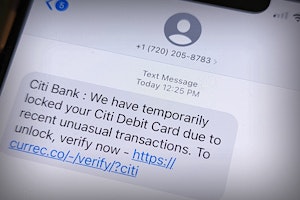
Most Read

Shipping Scams Use Fake Emails to Steal Your Information

FedEx Text Scam: Fake Delivery Alerts & Notifications

Get an Unexpected Delivery Alert? It May be a UPS Text Scam

6 Common FedEx Scams Meant to Steal Your Info & Money
Beware of the Parcel Tracking Text Scam
DHL In Depth
DHL is a logistics and delivery company that enables individuals and businesses to send and receive packages all over the world. Founded in 1969, DHL has over 400,000 people working in upwards of 220 countries and sovereign territories.
DHL has a combination of business and consumer solutions, including DHL Express, Global Forwarding, Supply Chain, Freight, and DHL e-commerce. It serves a variety of business sectors, ranging from chemicals and energy to retail and technology. Because DHL ships around 1.6 billion parcels every year, fraudsters have plenty of opportunities to take advantage of its systems and customers.
Common DHL Scams
DHL, being such a well-known brand, unfortunately, has become a target of scammers, who impersonate the brand in an attempt to steal information from innocent people. The first step in protecting yourself from DHL scams is to be aware of how these scams work and the red flags to watch out for.
Companies Pretending to Be DHL Online
Fraudulent actors have been known to use the DHL logo, font, colors, and other brand elements to impersonate the company. In this way, they are attempting to gain the confidence of online shoppers. They then request payment for the shipment of an item before it gets delivered. After paying for the supposed shipping costs, the user doesn't get what they ordered.
Fake DHL Email
Malicious actors also send fake DHL emails that sound like they come from the actual company. The email may ask for payment from the victim or it may ask the user to provide login or financial information. In some situations, the hacker may try to get you to click on a link to a fake DHL website to enter sensitive information.

The email can also contain malware within files or links to malicious websites. DO NOT click on any links or download any attachments.
Fake DHL Websites
Scammers also set up websites using DHL logos or branding material. On the surface, the site may look authentic. The scammer may then use data entry fields on the website to collect financial information, payment for services that won’t be rendered, or the personal info of customers.
Fraudulent SMS Messages
A scammer may also send you a fake SMS message, pretending to be someone from DHL. The message will often contain a link they want you to click on.

After clicking the link, you’re brought to another scam site or one that asks for personal information. The link may also carry you to a site that can infect your device with malware.
Fraudulent Social Media Accounts
People have set up fake DHL social media accounts using common social media outlets like Facebook, Instagram, and Twitter, as well as WhatsApp. They then either reach out to people directly or put up posts advertising offers such as “free Visa,” other free offers, or unbelievable investment opportunities.
Hacked DHL Accounts
Scammers may get their hands on your username and password and then hack your account. They can then place and pay for orders while pretending to be you. They can also take your account details and sell them to another hacker—either as a single account or within a package of several hacked accounts. In this way, they attempt to make a quick profit off your hacked account.
How to Beat DHL Scams
DHL can be a safe, reliable company to use for your personal and business shipping needs—as long as you look out for signs of scammers. To beat DHL scams, you can use these tips:
- Never click on anything in an email supposedly from DHL if it ends in anything but @dhl.com (or other country variation, such as @dhl.fr for France).
- Look out for DHL scam emails that have “DHL” in the first part but end with extensions such as @gmail.com, @hotmail.com, or @yahoo.com.
- Never click on a link to a website in an email from DHL other than one of their own. You should check the link’s address before clicking by long-tapping or hovering over it with your cursor.
- Do not click on anything in an SMS message that appears to be from DHL if it starts with https://bit.ly/ because a hacker may be using that to hide where it's really coming from.
- Never click on a link in an SMS that doesn't have a regular number in it but instead has something broad or generic, like “Delivery.”
- Do not click on links in messages that seem like they’re from DHL but have a country prefix other than the one you’d expect.
- Don't click on links in text messages that claim to be from DHL but the URL isn't a genuine DHL website.
- Avoid emails that claim to come from DHL but have deals that seem too good to be true.
- Discard any “DHL” communications and ignore any posts from “DHL” on social media that advertise outstanding deals or contain unrealistic offers.
- If you get a message about a change to your account, try to log in right away and change your password.
Report DHL Scams
The moment you notice something suspicious, you should contact DHL and explain what happened, as well as the nature of any communications you received—whether or not you responded.
Report Suspicious Emails
If you’re using a desktop computer, you can drag and drop the suspect DHL scam email into a fresh message and send it to [email protected]. If you’re on a mobile device, you can forward the message to that same email address. You should also mark that message as spam in your email app so your email provider can recognize it as such in the future.
Report Fake SMS Messages
If you get a suspicious SMS message, you can send a screenshot to [email protected]. You should also include the number it appeared to come from in your email.
Report Fraudulent Social Media Accounts
If you suspect a social media account of being fraudulent, you should report it to [email protected]. If you saw a suspicious post or noticed other questionable activity, you should also include that info in your message.
Report a Hacked DHL Account
If you think your account has been hacked, you may be able to log in and change your password. If you can’t get in, you can reach out to DHL customer support.
What To Do if You’ve Provided Sensitive Information
If you clicked on a link and shared personal information, you should immediately change the passwords of all financial accounts and others that you use on a regular basis or play an important role in your life or that of your family.
If you clicked on a suspicious link, you should also check your computer or device for malware by performing a scan using a reputable antivirus or antimalware program. In addition, reach out to your financial institution and explain what happened. In many cases, they may advise you to cancel credit cards and debit cards and send you new ones.
Scams Impacting DHL

Shipping Scams Use Fake Emails to Steal Your Information
Scammers are sending convincing emails, posing as shipping companies and online shopping sites, in order to collect your personal information.

FedEx Text Scam: Fake Delivery Alerts & Notifications
FedEx is warning customers of a fake text alert going around regarding an issue with a delivery. Learn how to avoid this tricky scam.

Get an Unexpected Delivery Alert? It May be a UPS Text Scam
Scammers are using SMS messages to send fake alerts to customers regarding a package delivery. Here's what to know about this scam.
Beware of the Parcel Tracking Text Scam
Delivery companies like FedEx, USPS, and UPS are being impersonated in text messages instructing recipients to visit a scam website—here's what you need to know.

Selling on Facebook Marketplace? Beware of Fake Venmo Emails
Scammers are sending fake Venmo emails to Facebook Marketplace sellers in an attempt to steal login information and money.

Citibank Text Message Scam: Locked Debit Card Alert Is Fake
If you've received a locked debit card text message from Citibank, it's likely a scam. Don't click on the link and delete the text message.

PayPal Text Scam: Identify a Fake & Protect Your Money
Several versions of fake PayPal text messages are being sent to people worldwide. There are a few easy ways to tell which messages are scams and simple things you can do to protect yourself.

Navy Federal Scam Text: What to Know to Avoid Identity Theft
A Navy Federal scam text is going around looking to trick individuals into giving up their personal or account information. Here's what you need to know.

AT&T Spam Text: How to Identify and Avoid Scam Texts
AT&T customers who have received spam text messages need to be careful not to click the link included. Find out how to identify scams and how to block spam texts.

Fake Verizon Text Messages: How to Avoid a Scam
Verizon may send you text messages from time to time with account updates or data usage alerts, but beware—most of these aren't really from Verizon but scammers.
Guides To Protect Against Postal & Delivery Services Scams

6 Common FedEx Scams Meant to Steal Your Info & Money
Stay cautious when you receive unexpected text messages or emails from FedEx—they could be fake messages being sent from scammers in an attempt to steal from you.

5 Holiday Scams Waiting to Steal Your Joy This Season
Whether you donate to a charity this season or buy your family a new puppy, scammers are eagerly waiting to trick you into giving up your personal information in these holiday scams.

7 Easy & Effective Ways to Stop Porch Pirates
With online shopping on the rise, these 7 tips and tricks can help you stop porch pirates from stealing your packages this holiday season.

How to Get Verified on TikTok
Securing that little blue checkmark can mean brand collabs, sponsorship opportunities, or protecting your unique content from impersonators.

How to Tell if Nikes Are Fakes: From Tags to the Stitching
Nike is one of the biggest brands targeted by counterfeiters and scammers - be extra careful with Nike products from non-official retailers as you could end up with a fake
News About Postal & Delivery Services Scams

Urgent CDC Warning: Eye Drops Linked to 3 Deaths, Loss of Vision
The CDC is warning eye drops users of a rare bacterial infection from 2 brands of eye drops. The infection is resistant to antibiotics and has resulted in the loss of vision, loss of eyeballs and the death of 3 patients.

Banks May Refund More Zelle Scam Victims in 2023
Zelle scams have reached a serious volume. New reports suggest that banks are looking at new refund protections for customers in 2023.

Optus Data Breach - One of the Worst Cyberattacks in Australia
Hackers have gained access to 9.8 million customer records from Optus in Australia, exposing personal information such as driver licence, medicare and passport details.

Roe vs. Wade Overturned: Abortion Rights in Your State
Find out what the overturning of Roe vs. Wade means for abortion rights in your state.

Searches for "COVID Vaccine 5G" Hit All-Time High, But Microchips Definitely Not in Vaccine
The number of people searching for the term "COVID vaccine 5G" on Google has just hit an all-time high, but there's one way to be sure that there are no microchips.
